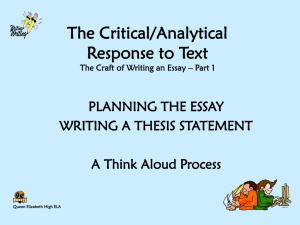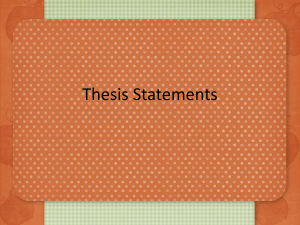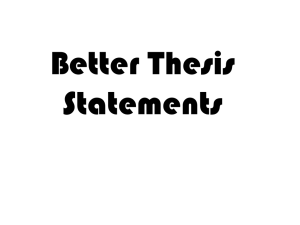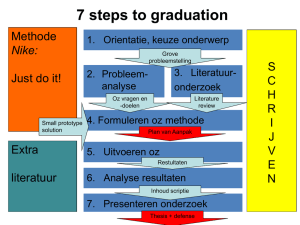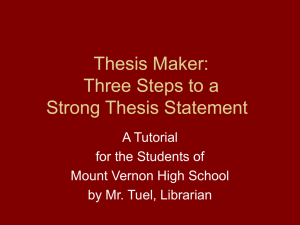File - Hunni ELA 30-1
advertisement
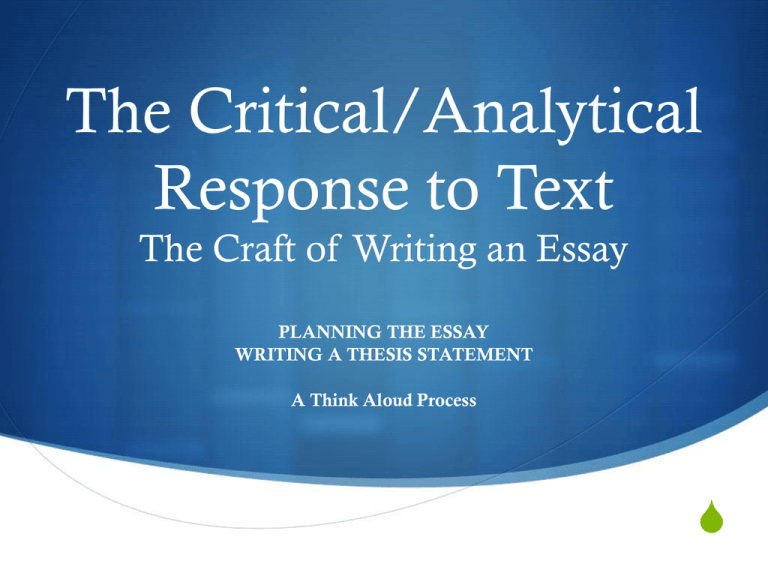
The Critical/Analytical Response to Text The Craft of Writing an Essay PLANNING THE ESSAY WRITING A THESIS STATEMENT A Think Aloud Process S STEP 1: Reading The Prompt and turning it into a QUESTION S For a literary essay: S Read the prompt carefully and annotate S Turn the prompt into a QUESTION you can answer. S Essay question / prompt is normally thematic and can be related to a wide variety of texts. The Question Change the statement into a question (that you can answer) related to a specific text of your choice With reference to a text you studied in class, discuss the ideas developed by the text creator regarding how individuals struggle to come to terms with their sense of identity. How does a character struggle to come to terms with their sense of identity? Why does a character struggle to come to terms with their sense of identity? When (or under what circumstances) does a character struggle to come to terms with their sense of identity? S The more specific your question – the better your answer “argument” will be. STEP 2: Interpret the Essential Question (work the prompt) Your interpretation should strike the reader as an “aha” rather than a “duh” observation. S Underline the key thematic words: identity, struggle, come to terms with S Denotate & Connotate the words S start to develop your own interpretation: how do we determine what ‘identity’ is? S how will you define/describe identity? S what factors may cause a ‘struggle to come to terms’ with identity? S STEP 3: Decide on a text Now work interpretations to suit your chosen text S Brainstorming: List the texts studied and decide how each text fits your interpretation remember, sometimes your most obvious text is not always the most interesting choice. Deciding on the Text(s) continued … What do you think the author/director suggests about various aspects of identity in your chosen text? S Who gives the character(s) their sense of identity? S What gives the character(s) their sense of identity? S What does the text say about identity? S The assumption is that you know your texts inside out and have developed your own ideas in relation to the text. S What text(s) connect with your interpretation? Step 4: Brainstorm a subset of questions and then answer them! These help develop your explorations and analysis’. As you do so, think of possible answers. Let your imagination roam over all possible questions: S How is a sense of identity compromised in the text? S Which character’s (or characters’) responses to this struggle intrigue me? S How does / do the character/s display their identity and does their sense of identity change throughout the course of the text? S How does / do other character/s contribute to/reinforce the main character’s sense of identity? S Which character’s (or characters’) responses best demonstrate a struggle with their own sense of identity? S What is the nature of the character’s (or characters’) struggle (internal/external)? S Who or what is holding them back from achieving a secure sense of identity? S How does the character (do the characters) of your choice attempt to create/come to terms with a new sense of identity? S Is a secure sense of identity achieved in the end by the actions of your character(s) and if so how? Step 5: ANSWER your QUESTION with your interpretation, your chosen text(s), your chosen character(s). S How/Why/When (under what circumstances) do / does (name character/s) struggle to come to terms with their sense of identity in author’s (name text)? S ARGUMENT / CLAIM (will become a THESIS): _________________________________________________________ _________________________________________________________ S The Blueprint: create at least three supporting arguments (will become your BODY) that support your main argument/claim. __________________ _________________ ________________ Step 6: Evidence S From your three supporting arguments that support your main argument/claim, give specific evidence to support the arguments. S Use quotations, paraphrasing, summaries from the text S Be specific and relevant when choosing your evidence from the text to back up your point! Step 7: Write your thesis S A good thesis is not only a debatable claim, but also suggests the structure of the paper. The thesis allows the reader to imagine and anticipate the flow of the paper: S Your statement should: State the subject S State your interpretation (insight /claim/ argument/ assertions) S Refer the text (if you have not already done so in your introductory paragraph) S State specific character(s) involved (if not already done so in your intro) S State your blueprint: the sequence supporting arguments that logically prove the essay's thesis (this may be a separate sentence in your intro) STYLE of the THESIS: S Present tense S It should be written as a compound-complex sentence. S FORMULA THESIS (When in doubt, try this) Write a formula thesis this way (this is satisfactory): S In (name of text), (author’s name) develops the idea that … through ..., …, …. Example of a THESIS Think about it this way: S By looking at the way Jamal and Forrester change during the course of the film, we see that individuals may hide their true identities from the people around them and the outside world which is significant because it is only when they reveal who they really are that they are able to live fulfilling lives. Write a THESIS this way: S In the film Finding Forrester, the director, Gus Van Sant, develops the idea that individuals may hide their true identities from the people around them and the outside world; however, it is only when they reveal who they really are that they are able to live fulfilling lives. Step 8: Test your thesis (CSSMI) “Kiss me” Clarity: Use straightforward language – avoid reference to philosophers/philosophies, metaphors or cliche Specificity: Is your thesis it too vague? For example, the statement “Gus Van Sant’s characterization demonstrates his incredible insight as a director" is too vague because your reader can't be sure what you mean by "insight" or how it relates to "characterization” Strength: S S S Make sure you have at least three arguments that support your thesis Make sure you have evidence for each argument Each argument should be the material for future body paragraphs Manageability: Interest: Can you handle the topic within the time frame/space provided? Does it state the obvious (“duh”)? If it's so obvious that nobody could fail to see it, it's probably not worth writing about. Find the “aha”! Intro and Thesis: Level 3 Satisfactory S Disadvantaged, basket-ball-playing, black teen, Jamal Wallace, meets eccentric, reclusive writer, William Forrester. Jamal is a gifted student and writer, but he hides his talent from his peers in order to be accepted. Likewise, Forrester is a prize-winning writer who wants no contact with the outside world and lives a life of isolation in his small apartment. At some level, both characters in the film Finding Forrester are denying their true identities at the start of the film, and it is only when the two meet that they are able to gradually break through the barriers that are holding them back from assuming their true identities. Director, Gus Van Sant, uses the film’s physical settings, costumes, and the motif of literature to explore this idea. S Good opening hook. / Two main characters are introduced, and the notion that identity can be ‘hidden’ is set up briefly to provide context. / There is no interpretation or explanation given of identity. / Blueprint needs context and clarification. / Expressions such as “Likewise” and “At some level” should be revisited. S Where is the thesis statement? Context is established, but not a thesis. Intro & Thesis: Level 4 Proficient Disadvantaged, basket-ball-playing, black teen, Jamal Wallace, meets eccentric, reclusive writer, William Forrester. In the film Finding Forrester, the director, Gus Van Sant, develops the idea that that individuals may hide their true identities from the people around them and the outside world; however, it is only when they reveal who they really are that they are able to live fulfilling lives. Although Jamal is a gifted student and writer, he hides his talent from his peers in order to be accepted. Likewise, Forrester is a prize-winning writer who wants no contact with the outside world and lives a life of isolation in his small apartment. At some level, both characters in Finding Forrester are denying their true identities at the start of the film, and it is only when the two meet that they are able to gradually break through the barriers that are holding them back from assuming their true identities. Director, Gus Van Sant, uses the film’s physical settings, costumes, and the motif of literature to explore this idea. Good opening hook. Thesis is strong and present. Two characters are introduced, and the notion that identity can be ‘hidden’ is set up briefly to provide context. There is no interpretation or explanation given of identity. Blueprint needs context and clarification. Intro & Thesis: Level 5 Excellence S Race. Employment. Family and friends. These are all factors that contribute to an individual’s sense of identity. However, the concept of identity is complex because an individual’s sense of identity is not fixed and is constantly evolving as both external and internal circumstances change. In the film Finding Forrester, director, Gus Van Sant, develops the idea that that individuals may hide their true identities from the people around them and the outside world; however, it is only when they reveal who they really are that they are able to live fulfilling lives. In other words, in order to establish an authentic sense of self and to live a truly successful life, it is necessary to overcome the fears and obstacles that may cause an individual to hide vital factors that contribute to his identity. In Finding Forrester, Jamal Wallace, a disadvantaged, basket-ball-playing, black teen, meets William Forrester, an eccentric, reclusive writer, and the identities of both characters are gradually transformed. Because of cultural, environmental, and self-imposed restrictions, both Jamal and Forrester hide their true identities, Jamal conforming to stereotypical behaviour to achieve the acceptance of his peers, and Forrester hiding from the outside world in the prison of his apartment. Neither character is living a fulfilling life; however, when they both face their challenges and fears, they are able to reveal their true identities and achieve their full potential. Director, Gus Van Sant, uses the film’s physical settings to convey the limitations placed upon the characters by their environments, the motif of literature to create a link between Jamal and Forrester, and clothing to depict Jamal’s and Forrester’s emerging and new-found identities.

